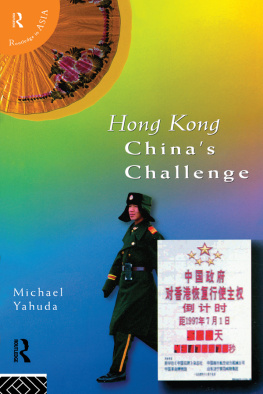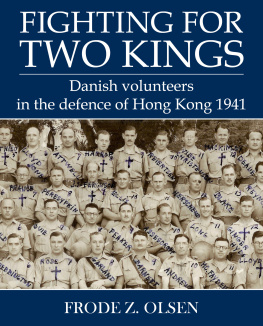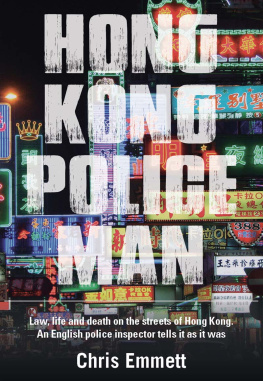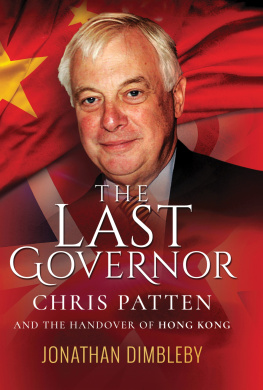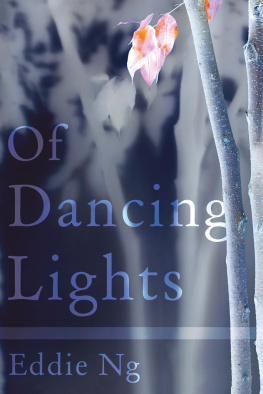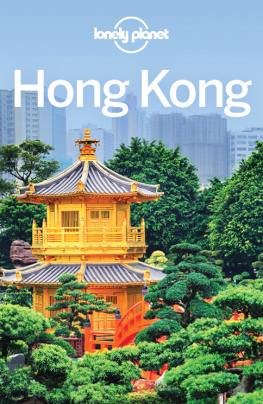Anglo-China
Chinese People and British Rule in Hong Kong 18411880
Anglo-China
Chinese People and British Rule in Hong Kong 18411880
Christopher Munn
First Published in 2001
by Curzon Press
Published 2013 by Routledge
2 Park Square, Milton Park, Abingdon, Oxon OX14 4RN
711 Third Avenue, New York, NY, 10017, USA
Routledge is an imprint of the Taylor & Francis Group, an informa business
2001 Christopher Munn
Typeset in Sabon by LaserScript Ltd, Mitcham, Surrey
All rights reserved. No part of this book may be reprinted or reproduced or utilised in any form or by any electronic, mechanical, or other means, now known or hereafter invented, including photocopying and recording, or in any information storage or retrieval system, without permission in writing from the publishers.
British Library Cataloguing in Publication Data
A catalogue record of this book is available from the British Library
Library of Congress Cataloguing in Publication Data
A catalogue record for this book has been requested
ISBN 13: 978-0-700-71298-4 (hbk)
For My Parents
Contents
The Province of Ontario, the University of Toronto and the University of Hong Kong generously gave me money to research and write the thesis from which this book derives. Various libraries and archives kindly granted me access to their materials. The staff at the following places were particularly considerate: the Inter-Library Loans Section of the Robarts Library, University of Toronto; the Special Collection of the University of Hong Kong Library; the Manuscripts Room of the Cambridge University Library; the Library of the School of Oriental and African Studies; the Public Records Office, Hong Kong; and the Hong Kong Museum of History. The Government of the Hong Kong Special Administrative Region and the Hong Kong Museum of History, Government of the HKSAR gave permission for the illustrations in this book to be reproduced. Jocelyn Scrymgeour, of Dunedin, New Zealand, kindly allowed me to quote from the diary of her ancestor, John Wright.
Many friends have encouraged and advised me in the course of my work on this book. Among them are Brenda Assael, Jerry Bannister, Kari Bronaugh, Robert Bickers, John Carroll, Blaine Chiasson, Virginia Crossman, John Erni, Fung Chi-ming, Dan Healey, Steve Heathorn, Susanna Hoe, Lucy Humbert, Milton Israel, Bernard Luk, Allyson May, Derek Roebuck, Kim Salkeld, Sun Daigang, Tsai Jung-fang, Gavin Ure, wannaPrasiT SunTaree and Peter Yeung. Friends at the Hong Kong Monetary Authority have been warm and solicitous in encouraging me to get the book out and into the shops.
My special thanks go to Tim Brook, Kenneth Chan, Robin McLeish, Elizabeth Sinn, Carl Smith, Silvia Van Kirk and Peter Wesley-Smith, and to my editor Jonathan Price. This book is dedicated to my parents, Patrick and Lucy Munn, with love and thanks.
Hong Kong, June 2001
(Between pages 238 and 239)
.
.
.
.
.
.
.
.
.
.
.
.
.
.
.
.
.
.
My aim has been to make the romanizations as unobtrusive as possible, to avoid applying any single, rigid system that might produce jarring anomalies, and to render Chinese words, as far as possible, in the sounds in which they would probably have been heard at the time. Chinese words have therefore been romanized according to the following principles:
1. Original romanizations, however unconventional by modern standards, have been retained in all quotations. This has been made necessary anyway by the fact that the original Chinese characters have generally not survived: the romanizations themselves (having, in many cases, probably derived from dialects other than standard Cantonese or Putonghua) are rarely clear enough to allow those characters to be re-romanized with any precision.
2. Identifiable place names in Hong Kong, Kowloon and the New Territories have been romanized from the Cantonese following current practices.
3. Names of people from the Hong Kong region taken from Chinese-language sources have been romanized from the Cantonese according to current practice in Hong Kong, which, with a few exceptions, is reasonably standardized.
4. Terms and institutional names peculiar to colonial Hong Kong have been romanized from the Cantonese according to common usage or according to the Sidney Lau system.
5. All other identifiable Chinese personal names, place names, and specialized terms are in pinyin, with the exception of cities (such as Canton and Peking) traditionally known in the English-speaking world by other romanizations.
Original spellings, capitals and italics have been retained in all quotations from the English, and no emphasis has been added. Punctuation has, however, been sparingly introduced or modified to conform with modern tastes.
Several currencies circulated in early Hong Kong. Silver Mexican and Spanish dollars (of roughly equal value) were the most common for the purposes of trade. U.S. dollars also circulated at about the same value as Mexican and Spanish. Government accounts were kept (and civil servants paid) in sterling until 1862, when the Hong Kong silver dollar came into being. Other currencies included East India Company rupees and Chinese silver taels and copper cash. Although exchange rates were fixed by official proclamation in 1842, real market values fluctuated from year to year. The rough exchange rates, for the purpose of the fines, salaries, prices and other figures recorded in this book, were as follows:
One dollar equalled about four shillings and twopence, 0.75 taels, or 2.25 rupees.
One pound equalled $4.80, or 3.33 taels, or about ten-and-a-half rupees.
One silver tael equalled $1.33, six shillings, or about three rupees.
A silver tael was theoretically divided into 1,000 copper cash, but, owing to the rise in the value of silver, it might be valued at up to 2,000 cash.
About twenty-four cash equalled a penny, making about 5,760 cash to the pound.
In the daily life of the colony, the purchasing power of these currencies was roughly as follows:
A pound of rice cost a penny-halfpenny (3).
A pound of pork cost threepence (6).
A pipe of opium cost about 15 cash (just over 1).
A pound of cheese cost about two shillings (about 50).
A bottle of wine cost about three shillings (about 75).
A quart of milk cost two shillings and threepence (54).
A gold watch was worth between $30 and $50.
A small, European-style bungalow could be had at a rent of about $150 a month; a larger house, with four or five bedrooms went for about $250 per month.
Salary or wage for various occupations in mid-nineteenth-century Hong Kong
Occupation | Salary or wage | In dollars per month |
Governor & Plenipotentiary (1844) | 6,000 p.a. | $2,400 |
Chief Justice (1844) | 3,000 p.a. | $1,200 |
Colonial Secretary (1844) |


